Embracing IT Innovations for AV Applications
As AV and control manufacturers evolve from hardware to software providers, we asked thought leaders about what the evolution might look like, and to give us a peek into their company’s near- and long-term roadmaps.
As AV and control manufacturers evolve from hardware to software providers—and in some cases offer cloud-based service platforms—we asked thought leaders from various companies to share their insights about what the evolution might look like, and to give us a peek into their company’s near- and long-term roadmaps. Read on as a broad selection of manufacturers discuss what you need to know about AV over IP.
1 Beyond: Rony Sebok, Vice President and Co-Founder
There’s a reason everyone is now talking about AV over IP. It’s no longer hype; it’s becoming reality. And there are many good reasons why.
1. Simplicity: simplifying wiring and routing of audio and video signals. 2. Cost: reducing the cost of equipment and installation. 3. Upgradability: adding features is easier when it’s a software upgrade and not a new piece of hardware. 4. Technology advancements: emerging standards that are able to transmit high-quality audio and video over standard network cables.
It wasn’t that long ago when you needed to connect four cables to use a PTZ camera: one each for power, control, high-quality video, and low-res stream. Now this can all be done over a single Cat 5 cable. Check out our new AutoTracker 3 with NDI camera. Better, yet, the cable can be connected to the nearest network switch and any device on the network has access to the video. It’s no longer necessary to think ahead and install specialty wiring to locations that might need access to the signal. All that is needed is a standard network connection at the location.
The same has been true for a while now with Dante audio. I can’t tell you how much easier that has made life for us. We can route audio from microphones to DSP and speakers and to our Automate VX voice-activated video switcher for recording and conferencing with Dante controller software.
Cost savings come because we don’t need to design in fancy XLR plugs or SDI connections on the system. Everything comes through the network—and software upgrades provide new features.
Read more about the status of the AV over IP transition.
A daily selection of features, industry news, and analysis for AV/IT professionals. Sign up below.

Download your free copy of The Tech Manager's Guide to the State of AV over IP.
We asked thought leaders from several of the industry’s top AV companies to share their perspective on the State of AV over IP and provide a glimpse of their roadmap.
AMX by Harman: Jamie Trader, Vice President, GPLM Video and Control
The premise that AV and control are moving “toward software solutions” might be accurate for some manufacturers, but it’s a flawed assertion from Harman’s perspective. Not incorrect—just flawed. It’s flawed because we’ve always been software-driven, software-defined. The best user experiences we’ve delivered to market are cultivated through software-enabled experiences. Whether we’re talking about DSP management, live sound mixing/recording, IP-based video distribution, enterprise resource control and management, or collaboration technology—all of this is underpinned by software. Software derived from obsessive focus on user needs and user behaviors.
The question is really about where software lives. Does it live on dedicated or general-purpose computing devices? Does it run on FPGA or SoC? Does it run on ARM or x86 processors? Does the software have a relationship between a purpose-built device and a general computing device? The answer to all of these questions is about application. Mission-critical applications often depend on purpose-built, solid-state reliability. Some applications rely on dedicated processing power that is difficult—or unreliable—to predictably harness from a shared computing device. On the other hand, many applications can leverage shared resources, and require both redundancy and standard IT-administered support that dedicated devices can’t satisfy.
The point of this is that the Harman roadmap outlines a continued commitment to delivering software-defined experiences across the best computing technologies fit for each application. Cloud plays a massive part in our AVL-integrated future. And which computing devices cloud will interact with will be both varied and meaningful.
Aurora Multimedia: Paul Harris, CEO and CTO
Aurora Multimedia’s near- and long-term solution is called ReAX, which is based on JavaScript and HTML. The advantage is the huge amount of resources and education available for a platform based on web standards. Most everything about ReAX is open architecture and non-platform specific. Using Node.js as its core, ReAX can run on embedded platforms, computers, and virtual machines using Windows, Linux, and Android. It can run locally in a facility or in the cloud, providing ultimate flexibility.
Aurora provides tools for drag-and-drop code development and WYSIWYG (what you see is what you get) interface creation; however, programmers can use code development software tools of their choice since ReAX is standards-based. The ReAX organization allows multiple manufacturers to use the technology. AV products utilizing the ReAX engine can eliminate the need for standalone hardware. It also allows for a variety of hardware and software to interoperate. Displays, media players, AV over IP, and more can run a ReAX engine. For the first time, in addition to protocols, source code, IR libraries, and macros can be shared between manufacturers. End users and integrators will no longer be held hostage by proprietary control system companies. ReAX is making a better and friendlier AV industry with its open-architecture technology.
Read more about AV over IP distribution for commercial integrators.
Black Box: Jonathan McCune, Director of Product Management, AV and Infrastructure
Black Box has a track record of providing reliable, long-lasting AV distribution and remote-access solutions. Our key focus for the future is to continuously develop AV, KVM, and control platforms that are future-proof. Rather than force customers to replace their entire system architecture, we will ensure that they can upgrade or enhance their existing systems with IP-based or virtual machine access-enabling components. This approach secures customers’ IT investments while providing them with a migration path to new technology.
Our current and future development roadmap includes AV-over-IP distribution systems that securely share data payload and high-resolution AV signals on the same infrastructure. These include high-speed, IP-based KVM extension and switching solutions that provide access to physical and virtual machines in data centers, as well as pioneering software-based KVM that replaces physical KVM receiver units. All of these solutions reflect a basic value: ease of use, even as technology evolves. Black Box solutions provide administrator-friendly management interfaces that keep up with the speed of changing technology by providing secure access over an IP network or even the internet, plus a high degree of system scalability and support for future system enhancements.
Crestron: Daniel Jackson, Director, Enterprise Technology
Crestron is focusing on building the complete integrated solution for our customers. If our customers ask for something, we want to build it. Not because we want to build everything, but we want to build in areas where it makes sense, and design solutions to work together as opposed to being cobbled together after the fact.
We want to own all the pieces to provide a better experience to end users. Alternatively, if an integrator has to go to different manufacturer each time a customer asks for something, it becomes a huge hassle, not just from the end-user perspective but from the management, support, and training perspective as well. Unified communications is a great example of this, because UC has become a big part of what customers want in their rooms, so we built that into our portfolio to provide a seamlessly integrated system.
End users are starting to demand more technology in every room, as opposed to just high-end or specialty rooms. A lot of what is driving that demand is the fact that you can now get very inexpensive video systems. We sell a very developed Flex solution at a radically low price point. That is causing people so say, “Wow, I should probably go add video to these rooms.” And now, all of a sudden, you can get video in these rooms for peanuts. This is also driving massive scale.
People often ask if Fusion is going away and being replaced by XiO Cloud. No, Fusion will be around for at least the next decade and we’re still doing future development.
XiO Cloud and Fusion are different solutions. Fusion is for customers that want to do complex, custom designs—but that comes at the cost of some simplicity. XiO Cloud gives you simplicity and allows enterprises to easily scale.
XiO Cloud does certain things out of the box like zero touch. Because our devices know how to reach out to XiO Cloud, they’ll pull down all their configurations and settings and it will automatically record the analytics off the devices.
We’ve found that nobody wants to run servers in their own data centers anymore. If the customer needs a dedicated cloud, we have Fusion Cloud, which is our hosted solution. We effectively provide a dedicated virtual machine, but it’s in a cloud, so you don’t have to set up your own infrastructure. XiO Cloud is truly a cloud-native platform—it’s designed from the ground up.
DVIGear: Matthew Pulsipher, Product Manager
I think the key opportunity for embracing IT innovations for AV applications is in software-defined hardware. There are a lot of IT-based standards for streaming audio and video, many of them very good. But the software-first approach that they take comes with unacceptable compromises in the context of professional AV, where quality must be uncompromised, and latency must be absolutely minimal. That’s why we decided on SDVoE as a platform: with SDVoE, you have a standardized cross-vendor hardware platform that is entirely controllable (and expandable) by software.
Even though they are ultimately delivered by hardware, DisplayNet-exclusive features such as Advanced Video Wall exist entirely in software. SDVoE hardware is standardized, with minor differentiation between vendors. Any SDVoE solution can perform basic AV routing (and even some control of advanced features) as well as any other, but the SDVoE platform is flexible enough that significant improvements can be made within the control software.
Since launching the DN-200 Series in 2017, we have been able to add a wide range of new features and functionality through continued development of DisplayNet Manager and by embracing enhancements made to the SDVoE platform. With SDVoE, the internal circuitry used for processing signals is software-defined, and firmware updates can change the configuration of the hardware to enable improved performance and additional features. I fully expect that we will be able to deliver continued performance enhancements and new features for years to come on our existing hardware—and that any new hardware we release will serve to extend that platform.
Extron: Joe da Silva, Director of Product Marketing
The demands placed on technology in the modern workspace are constantly evolving because of AV over IP and other trends in 2020. One example is how technology managers are being asked to support flexible and scalable solutions that can deliver real-time, high-quality communication for presentations as well as collaborative interactions throughout an office, building, or campus.
Using the network for distribution of video and audio signals is garnering a lot of attention. Using encoders and decoders, we can stream these signals across an infrastructure that is potentially used for more than one purpose. The flexibility and scalability that AV over IP affords gives technology managers a greater range of interoperable options for deploying systems of nearly any scale. By integrating control as a native technology within the AV-over-IP ecosystem, it is now possible to leverage a common deployment workflow for small systems like you’d find in a huddle room to enterprise-wide distribution you’d encounter across a campus of buildings. Moving forward, we are excited to leverage the strength of our configurable and programmable control platform with the scalability of our AV-over-IP video distribution products. These solutions allow users to enable new features as the requirements of the applications change over time through simple software keys. This degree of flexibility ensures our customers are not limited by technology as the business needs of their organization change.
Hall Research: Sathvik Gaddam, Senior Embedded Systems Engineer
Distribution of video and audio over IP not only provides scalability, but also end-to-end control. AVoIP has transformed the way traditional audio and video is transmitted from point to point on a direct, wired connection such as coax or Cat-5 into distributed nodes and services utilizing IP technologies such as IGMP and Multicasting. This approach not only allows a sender to distribute content to a group of receivers, but also allows a receiver to subscribe to a given service from a sender. This flexibility allowed IP-based control systems to control and monitor AV distribution.
Moreover, AVoIP is no longer confined to just video and audio; expanding to applications in the medical and education fields, AVoIP has evolved to provide many services such as USB 2.0 (USBoIP), IR control (IRoIP), serial control (SoIP), and IP control along with audio and video. So far, AVoIP is confined to a Local Area Network (LAN) because of its bandwidth-intensive nature; however, control systems to manage AV are rapidly connecting to the cloud to give live status and control over the system, which is often the ideal case. While the technology to stream AV directly to a cloud server is already available, it’s not surprising that it is not widely adopted because of its expensive infrastructure and latency issues.
While AVoIP technology itself has evolved to satisfy present and future AV needs, deploying the AVoIP solution based on customer needs has become a major challenge for integrators as they must take the customer’s IT infrastructure into consideration before designing the solution. This was not a major concern before. Deploying AVoIP to existing infrastructure is even more challenging, as in most cases, customers’ IP networks are not configured to handle AV. Because of the tradeoff between network bandwidth, image quality, latency, and infrastructure costs, manufacturers offer numerous AVoIP solutions, which can become challenging for users to select the right solution.
Kramer Electronics: Clint Hoffman, CEO
AV over IP is a great alternative to HDBaseT for bigger installations. When it comes to the AV/IT end user, this is what they are familiar with. They’re not familiar with HDBaseT, or HDMI, EDID, and proprietary highways and matrix switchers. It’s an easy discussion because they understand managed services and the cloud.
We have three different primary solutions at Kramer. Kramer Control is a cloud-based control solution. The beauty of a cloud-based control solution is that you don’t have to roll a truck on site and send the program route with it to go make a change to the system.
Another benefit of Kramer Control is that from the minute you have deployed it, we use smart drivers for a display or a source. Kramer Control is completely about analytics. It captures all the activity from the day you turn the system on and is available to be analyzed. How often are my rooms being used? What’s being used in my rooms? It’s all available immediately and forever, because it lives on the Amazon Web Services server farms. You don’t need to have a coder who writes programs to get information out of your system.
Kramer VIA is a wireless collaboration and presentation solution. Then VIA Site Management allows you to do a multitude of things across your network, whether you’ve got 100 or 1,000 VIAs. You can check their status individually or push a firmware update to all of them.
Kramer Network is a tool for managing AV hardware that’s connected to a network, and it’s also a virtual matrix switcher for AV-over-IP encoders and decoders.
We have an AV over IP solution for every point in the market. We have the H.264/265, the M-JPEG, which is currently the most popular, and we also now have the SDVoE. And, we have 4K as well. No matter what the application is, we have solution for it, including traditional hardware. (For example, there's a Kramer AV over IP system running the digital signage at Tulalip Resort Casino.)
Our roadmap is to take these solutions and make them all seamlessly integrated and look and feel like they’re one.
QSC: Martin Barbour, Product Manager, Q-SYS Platform and Cloud Software
For almost 15 years, QSC has been developing its AV&C technology in a fundamentally different way than nearly every other AV company. In order to provide significantly greater performance and deeper integration capabilities, we chose to leverage mainstream IT stalwarts such as Intel, the IEEE, and Linux as the base technologies for Q-SYS. This approach allows us to define the product by the software we run with these well-known and trusted technologies. As a result, we can look at Q-SYS as an AV&C operating system.
This software-defined application layer gives us agility to offer Q-SYS on the most suitable platform for the application. Whether that’s partnering with an industry leader such as Dell for large-capacity, centralized deployments (with the Q-SYS Core 5200), or building our own appliance for smaller spaces (the Q-SYS Core 110f), or moving applicable capabilities to the cloud. Q-SYS embodies the fact that ongoing software development continues to define and evolve the product.
While QSC is increasingly becoming a software developer rather than a hardware manufacturer, there is still a need to manufacturer endpoints such as amplifiers, cameras, and other physical devices that cannot be virtualized. Beyond that, we don’t need to manufacture multiple hardware processors (audio DSP, control processor, video switcher, etc.) to tie those systems together. All of those functions can live at the software layer, and therefore, coexist in the same single device or software application.
As a software provider, the next logical steps (as evidenced by the IT industry) are virtualization and cloud deployment. The jury is still out on whether real-time signal processing in the cloud makes practical sense for the majority of use cases, but the technology certainly exists. What we do know is the convenience and improved efficiency offered by global visibility through cloud-connected devices. Q-SYS Reflect Enterprise Manager extends the Q-SYS Ecosystem by moving applicable technology pieces to the cloud for centralized, remote management and monitoring of your entire AV&C system including Q-SYS peripherals and third-party, non-QSC devices, from anywhere in the world.
RGB Spectrum: Scott Norder, Chief Operating Officer
We think about three main categories of AV content: live/capture video, time-sensitive computer-generated (think video games), and time-insensitive recorded/streamed content (web pages, video content servers). Each presents unique challenges in migrating to a software/cloud-hosted platform. The main factors of cost, performance, data transmission speeds, and bottlenecks balanced against quality, reliability, and ease of use are already producing a variety of solutions. Solutions for recorded/streamed content are approaching full maturation, yet there is still room for innovation in technology and business models.
Clearly, there will continue to be edge devices for the creation/capture of AV content and for the presentation of that content back to users. It is the area between these two functions where our opportunity exists. Whether you think of it as conversion, translation, encoding, or ethernet enablement, it is the cost-effective processing and packaging of the AV content that must happen in order to move the AV content across the network from the edges. Implementing standards-based solutions in this area—such as H.264/HEVC or JPEG2000—provides maximum leverage of interoperability, reliability, and cost reduction, and is clearly being favored by the marketplace.
RGB Spectrum is focused on the challenges of getting time-sensitive content distributed, processed, and displayed across wide user bases by leveraging best-in-class AV codecs, networking, and distributed control. Our solutions provide everything needed to get AV content onto your network and distribute it not just within a room, but to every room, building, campus, or facility around the world.
Utelogy: Frank Pellkofer, President
As the demographics in the workplace change, many organizations need to meet the enhanced expectations of a new breed of technology users. The new AV/UC deployments are driven by a desire to make life simple for their customers whose daily life is to maximize productivity through workplace technology. The need for efficiency and to create an environment that is attractive to recruit new staff and retain existing employees is now of paramount importance as many organizations focus more on the value of their people.
We’re seeing a proliferation of huddle spaces (small meeting rooms) that need simple, inexpensive, and easily deployed and configured solutions that provide a first-class user experience. These include intelligent soundbars with integrated microphones and cameras, intelligent cameras/displays that provide actionable intelligence (people counting etc.), wireless presentation devices, and sensor technology to automate the control of the space.
Our roadmap is focused on ensuring our solution is enterprise-grade, network-connected, secure, able to be managed and monitored, and able to provide IT/enterprise levels of service. We are seeing a change in the types and volumes of rooms that are being installed and also the way that the technology is being consumed, with the IT-style “as a service” model starting to be adopted.
ZeeVee: Steve Metzger, Co-Founder, VP, Hardware and Operations
This is an exciting time for the AV industry. Within the last decade we have seen AV distribution grow from analog patch fields through digital HD over RF, matrix switching, HDBaseT, and now, into Ethernet and the internet for distribution. That’s probably the fastest rate of change for any industry outside of micro-processing and silicon storage technologies.
While AV over IP and internet-based serving of video are hot areas of development—and we fully participate in it with cutting-edge products and services—it is but one answer to one type of challenge. As with any high-tech area, there is a continuum of technology and solutions best suited to each customer’s problem.
There is no single solution that is going to work for all customers universally. If you have medical operating theaters or control room applications, the requirements are stringent in terms of video quality and latency, and the price paid is bandwidth and network capacity. School systems tend to be more budget focused. Sub-frame latency may not be as important, so compressed solutions fit the bill. We have leading solutions for those applications as well.
As a customer-focused vendor, our job is not to shoehorn anyone into the technology du jour. Our job is to provide the breadth of solutions that can cover any of our partner and end-user needs—but more importantly, the knowledge, interest, and passion to learn about those needs and apply the very best-suited solution to best cover them.
SDVoE Alliance: Justin Kennington, President
There is a hidden challenge to the convergence of AV and IT: Networks originally designed to serve traditional IT needs are not well-suited to carry AV traffic. These networks are heavily oversubscribed. That is, their peak data-carrying capacity is low compared to their aggregate traffic over time. This is an IT best practice, because oversubscription lowers infrastructure costs and has little performance impact for IT users (web browsing, email, file transfers). But oversubscription is the enemy of AV over IP, because AV data must be delivered on time, every time, without delay or network retries.
Practically, this means that the idea of using AV-over-IP endpoints on your existing infrastructure is a lie. Adding any major new service to your network requires planning, design, and expansion. AV over IP is no exception. Therefore, we expect to see an evolution toward new and expanded networks that break the traditional IT design mold and account for the increased peak bandwidth demands of AV over IP.
A strong recent example of this evolved thinking is at Yale University’s Sterling Law Building. Integrator North American Theatrix worked with Yale’s IT staff to integrate a new segment into their existing network with multiple 100Gb links between switches. This new network segment offers peak bandwidth capabilities far beyond that of a traditional network design. The resulting network connects all AV for more than a dozen classrooms, while also providing IT service to the building.
The latest AV-over-IP products from leading companies
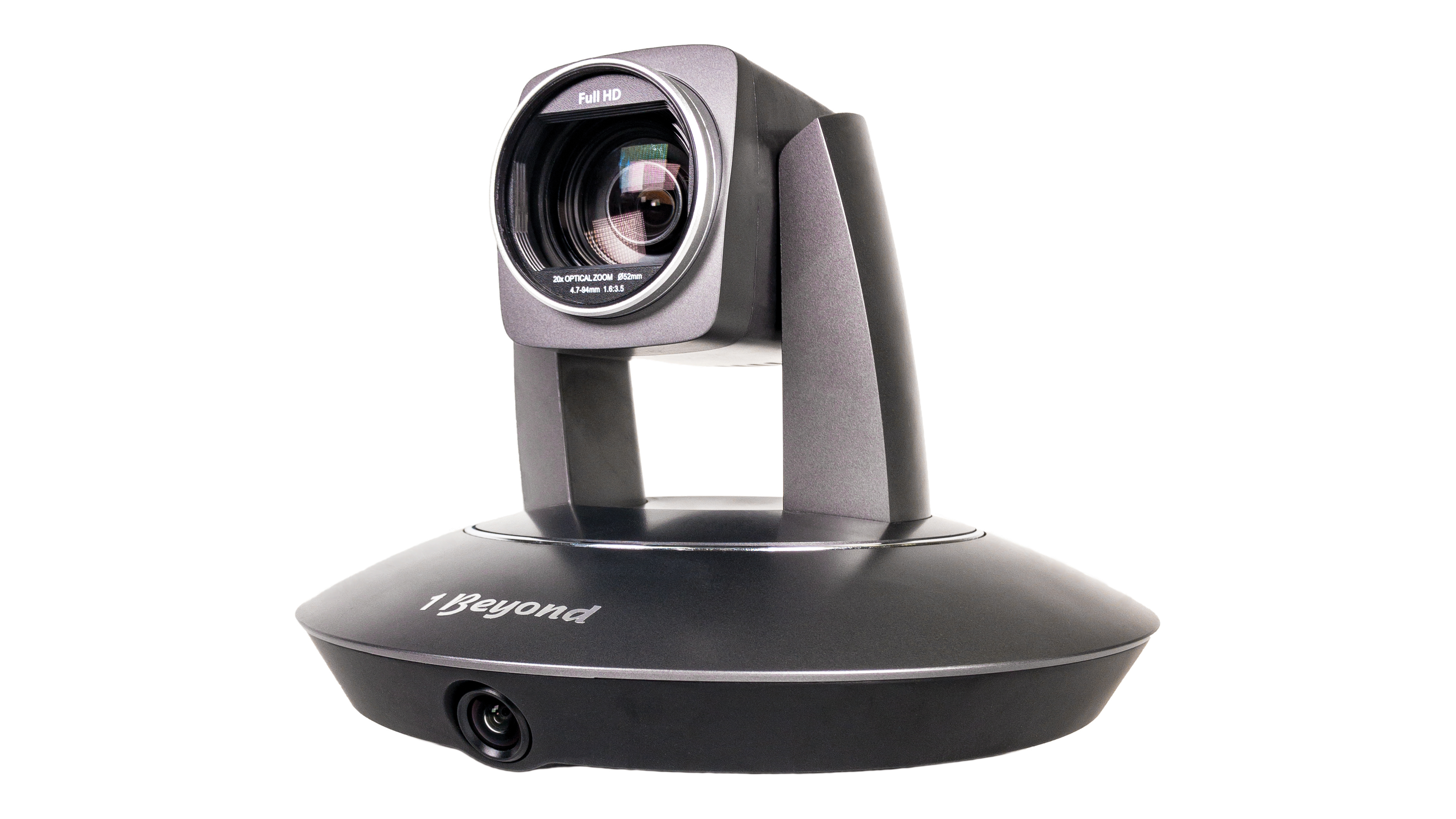
1 Beyond AutoTracker 3
The 1 Beyond AutoTracker 3 is now available with NDI, one of the emerging AV-over-IP standards for video. It can be decoded with software and many software products support it. The AutoTracker camera automatically follows a teacher walking and speaking. With NDI encoding built into the AutoTracker, only a single Cat 5 cable to the camera is required. The Panopto system in the Smart Display has Wi-Fi access to the video, anywhere in the room. 1 Beyond Automate VX voice-activated switching solution also supports NDI for input and output. It was shown at InfoComm with 9 NDI sources being switched automatically.
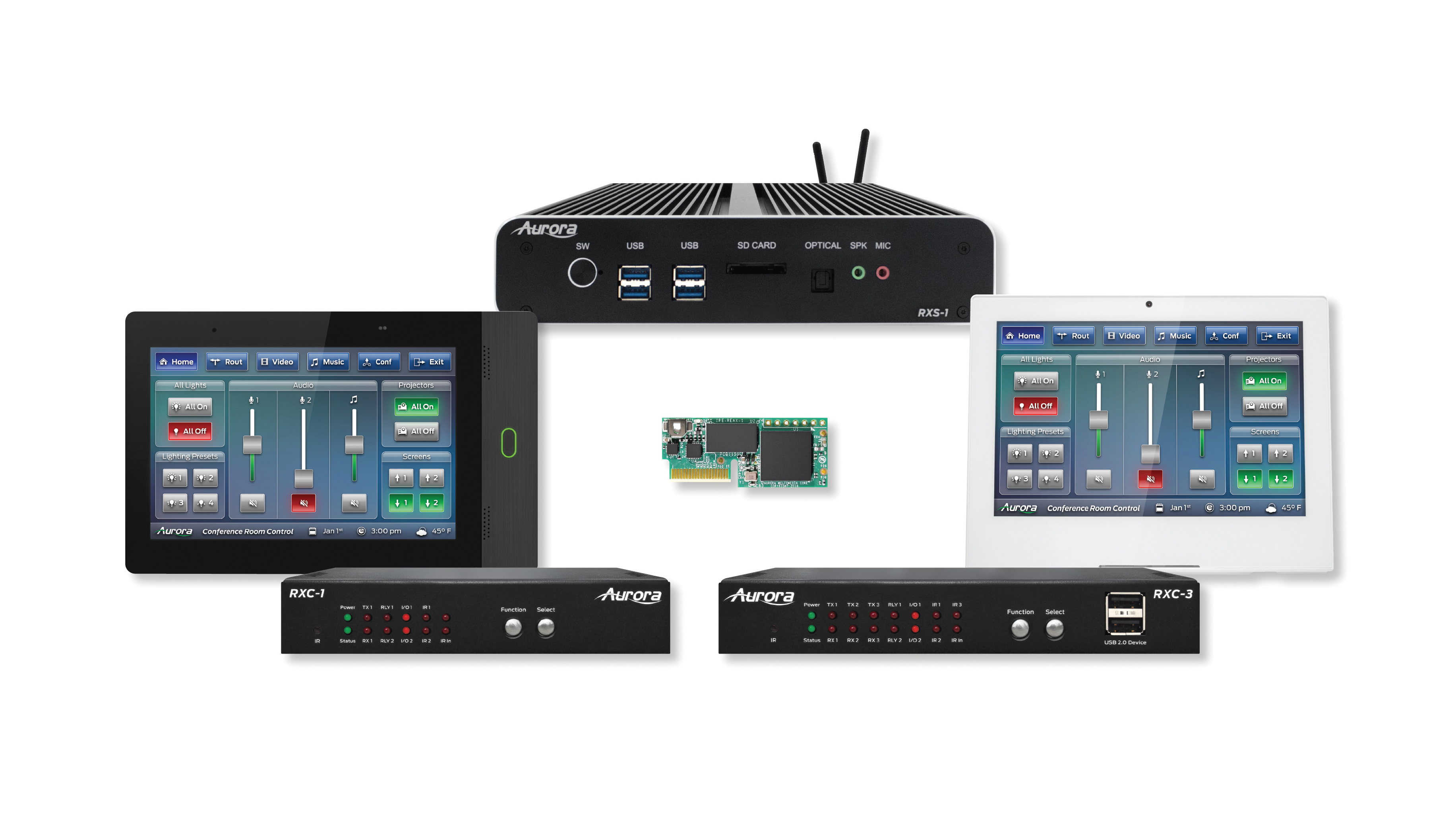
Aurora RXT Series
Aurora has introduced a variety of IP control interfaces and control units based on ReAX technology. The RXT Series are 7- and 10-inch Android wall-mount and desktop touch interfaces available in black or white, which also serve as the “brain” of the system. The RXC-1, RXC-3, QXP-2, and QXC-44 are Linux control units that have a variety of control ports like RS-232, IR, I/O, and relays. The IPE-ReAX-1 card allows a ReAX engine inside Aurora 1G or 10G AV-over-IP system. All devices are PoE, simplifying wiring by eliminating external power supplies. The Core Studio is a free and simple-to-use tool for code and interface creation using drag and drop. Overall, the ReAX hardware provides power and performance at affordable prices.

Black Box Emerald KVM
Black Box’s Emerald KVM-over-IP and MCX AV-over-IP platforms enable distribution, extension, and sharing of up to 4K video, audio, and peripheral signals over IP. The Emerald KVM product family connects users with both virtual and physical machines hosted in a secure data center. The zero-client platform is future-proof and scalable, and it prevents a “technology lock-in” by building bridges to both legacy (non-IP) KVM systems, as well as current and future interfaces and standards. The MCX AV-over-IP platform ensures low latency, bandwidth efficiency, and high-quality video and audio over modern 10GbE infrastructures. This simplifies and accelerates the process of consolidating AV and data on a single network, enabling organizations to reduce network management time and costs and scale for expansion.
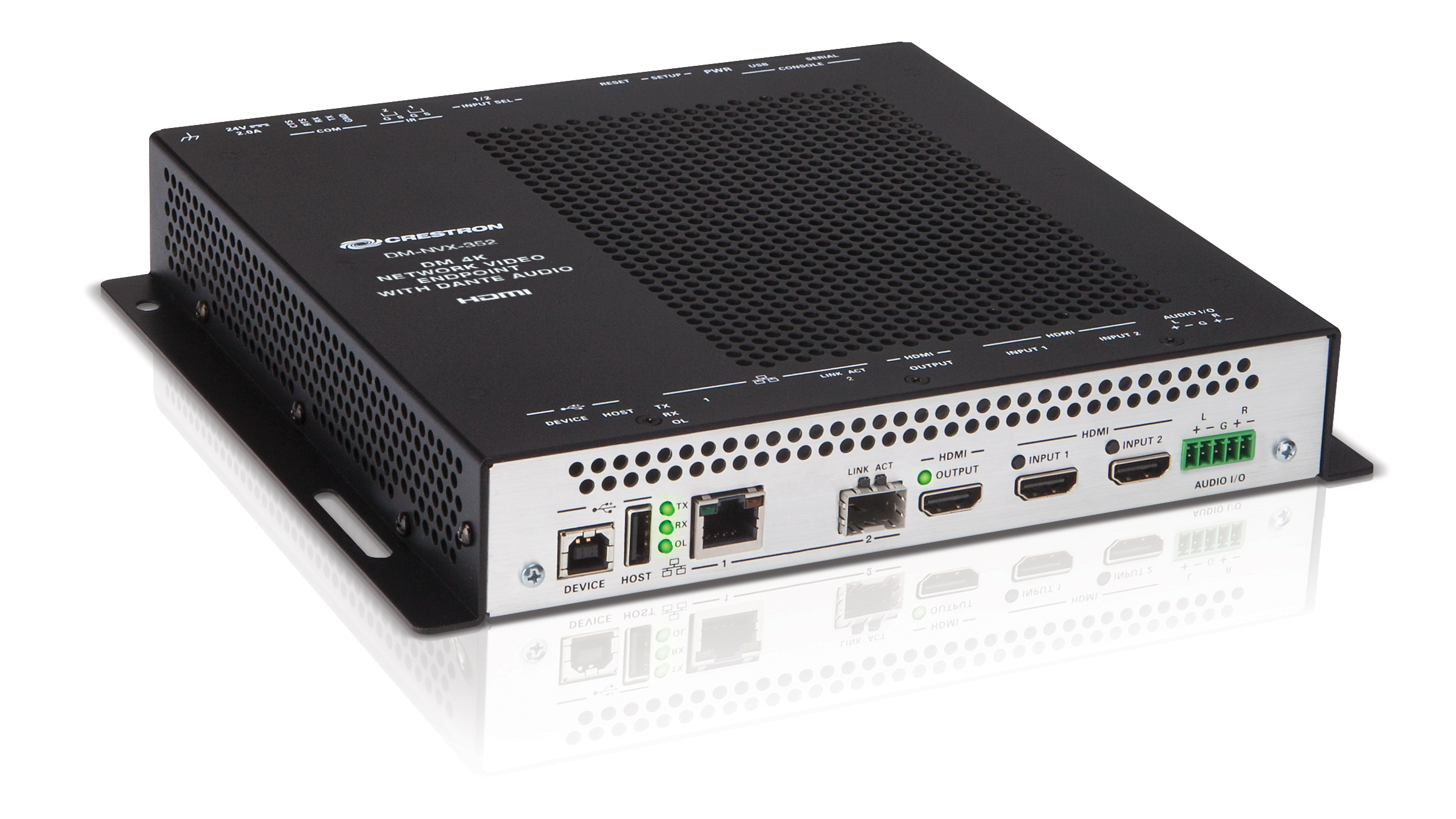
Crestron DM NVX
Crestron’s DM NVX technology transports ultra-high-definition 4K60 4:4:4 video over standard gigabit Ethernet with no perceptible latency or loss of quality. Leveraging standard network switches and Cat-5e UTP wiring, the DM-NVX-352 delivers a high-performance virtual matrix routing solution that is scalable for any enterprise or campus-wide 4K content distribution application. Professional onboard scaling, plus support for HDR10 and HDCP 2.2 ensures a high-quality picture with compatibility for varied media sources. The all-new Pixel Perfect Processing technology further enhances the image quality.
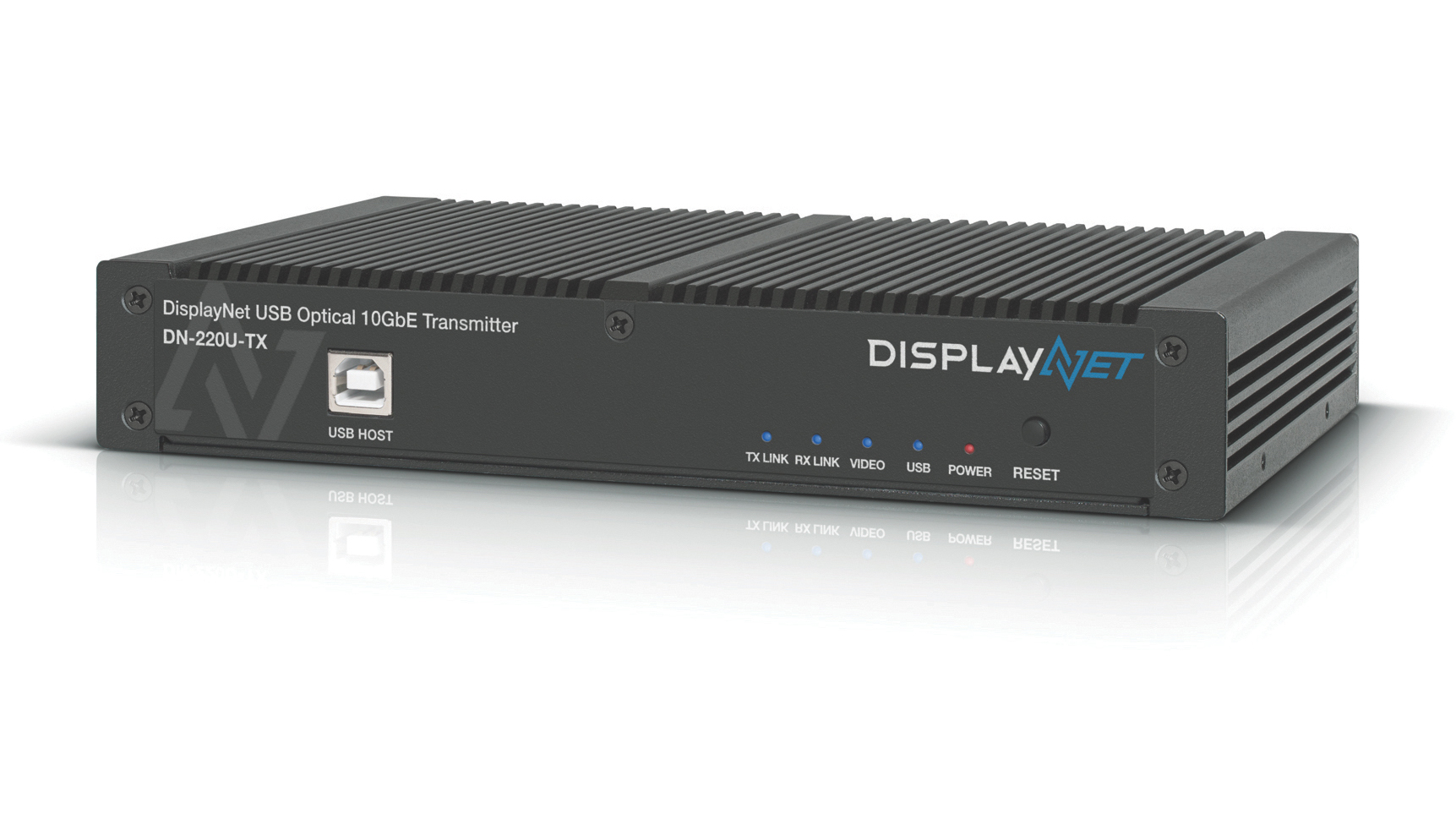
DVIGear DisplayNet
Powered by SDVoE technology, DVIGear’s DisplayNet products provide flexible AV distribution with zero-frame latency, artifact-free image quality, and near-infinite scalability. DisplayNet delivers multi-layer switching and allows for limitless expansion with any combination of transmitters and receivers. DisplayNet supports both HDMI and DisplayPort 1.2 at 4K/60Hz with up to 12-bit color and HDCP 2.2. The DN-200 Series includes a high-performance video processing engine that allows for very fast signal switching, multi-viewing of up to 32 simultaneous sources, and advanced video wall functionality. The DN-150 series limits the DN-200’s Video Processing engine to deliver matrix switching performance for applications in which video processing is not needed for every endpoint.
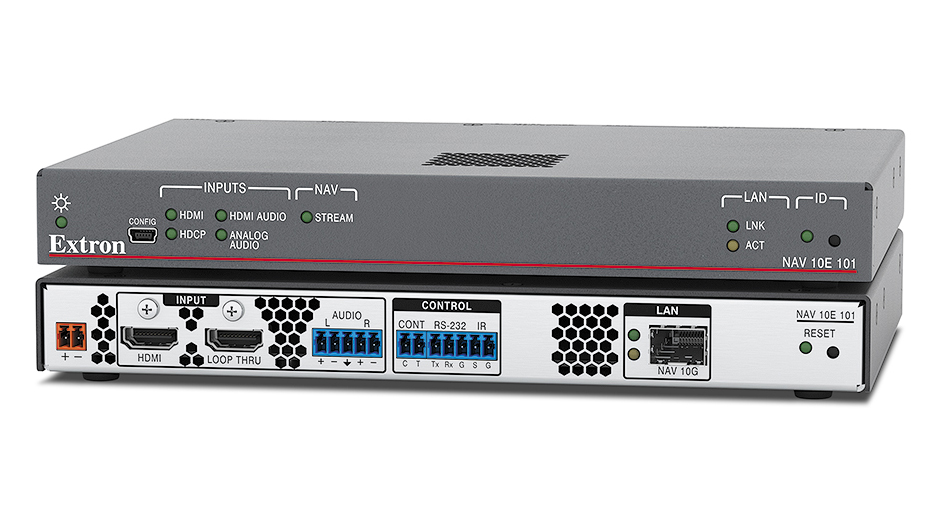
Extron NAV Series
As the adoption of AV-over-IP solutions increases, technology managers are faced with organizational challenges such as adding another service onto existing networks. Most end users have a 1Gbps network infrastructure. Even with the new demands of AV over IP, not every organization is ready to move to 10Gbps networks. Extron’s NAV Series offers encoders and decoders for both 1G and 10G networks with full interoperability. The patented PURE3 codec in NAV encoders and decoders provides high-quality video with virtually no latency at efficient bitrates, allowing for a seamless upgrade paths as network technologies change.
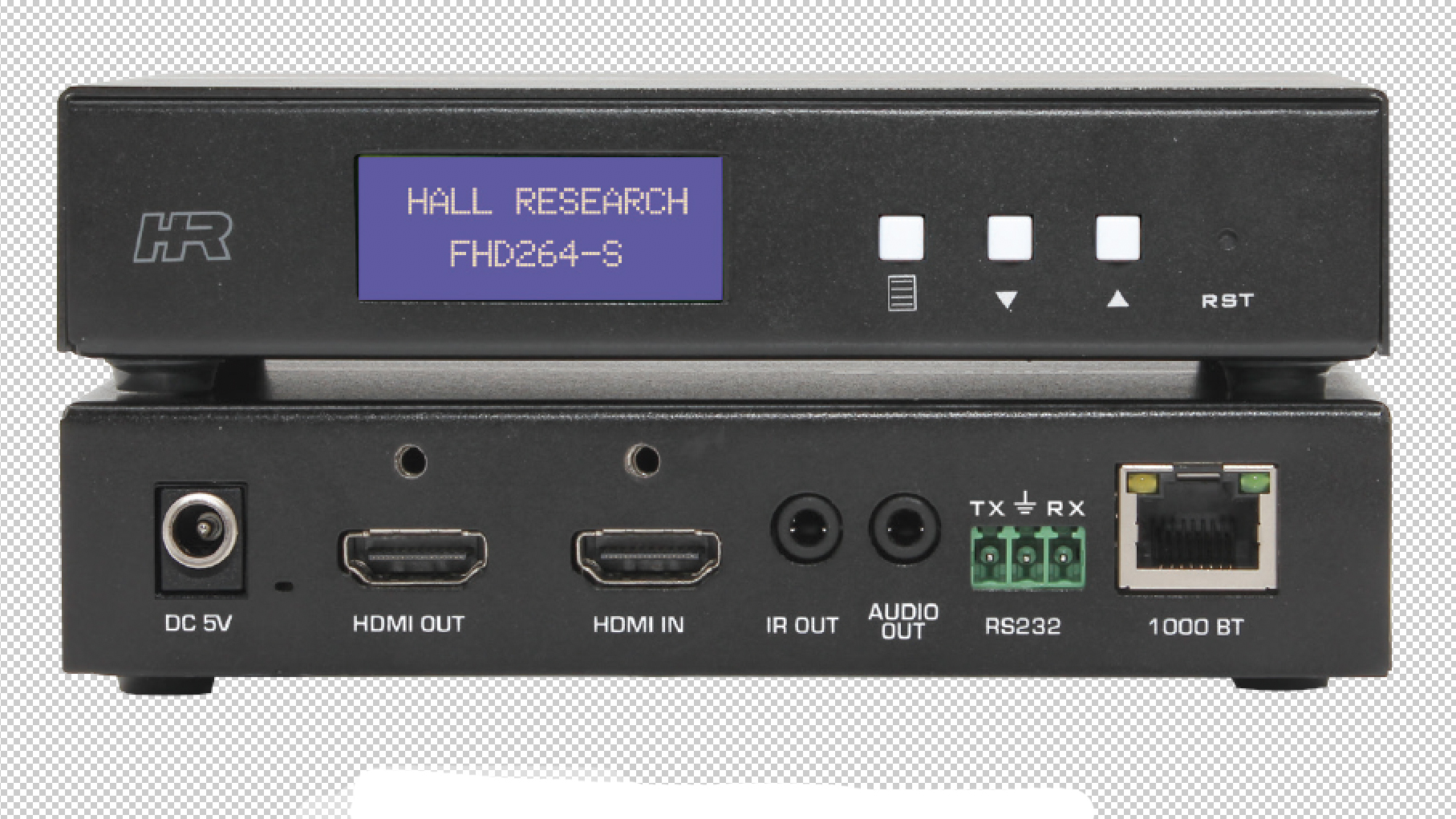
Hall Research AVoIP Solutions
Hall Research’s FHD264 (pictured) system uses H.264 encoding to deliver 1080p video with under 35Mbps of bandwidth. It can extend IR and RS-232 over IP to deliver video to virtually unlimited endpoints. The VERSA-4K AVoIP solution features lossless 4K video with zero latency, USB 2.0, keyboard and mouse, IR, and RS-232—all under 1G bandwidth. It can create a video wall, has independent routing, USB filtering, dynamic virtual matrix (DVM), and PoE. VERSA-4K provides a solution for PC extension, presentation systems, and digital signage where quality and latency are major concerns. Both FHD264 and VERSA-4K can be controlled and managed using the CNT-IP-264 Control System. With an embedded web server and scheduler, CNT-IP-264 not only discovers Hall Research AVoIP products in the IP network but also allows it to control third-party products over IP and RS-232 from its WEB-GUI.
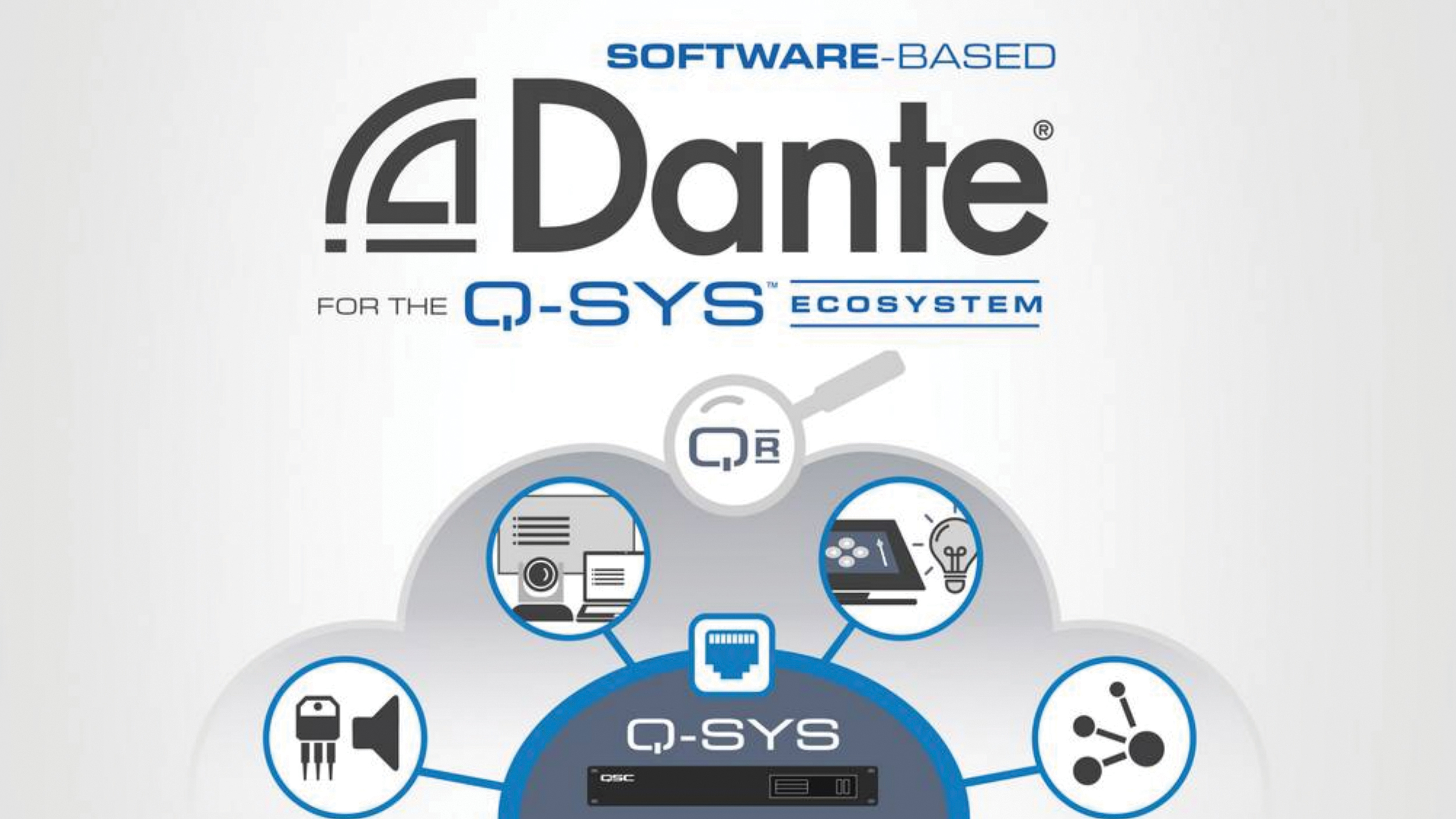
QSC Q-SYS
As part of its strategic technology partnership with Audinate, Q-SYS feature licenses will enable native Dante networked audio integration without the need for additional hardware I/O or external configuration software. Integrators can add Dante audio natively as an extension of the Q-SYS integrated audio, video, and control workflow. Robust functionality provides device discovery, synchronization, control, and management for Dante—directly within Q-SYS Designer Software environment or Dante Controller. Because Q-SYS operates over standard IT network infrastructures, Dante audio data works with Q-SYS AV&C data, eliminating the need for challenging bridging or combining schemes to manage both Q-SYS and Dante connected peripherals. Following the release of Software-based Dante feature licenses, all new Q-SYS Core processors will ship with a small set of Dante audio channels enabled at no additional cost. Software-based Dante for the Q-SYS Ecosystem is targeted for release in early 2020.
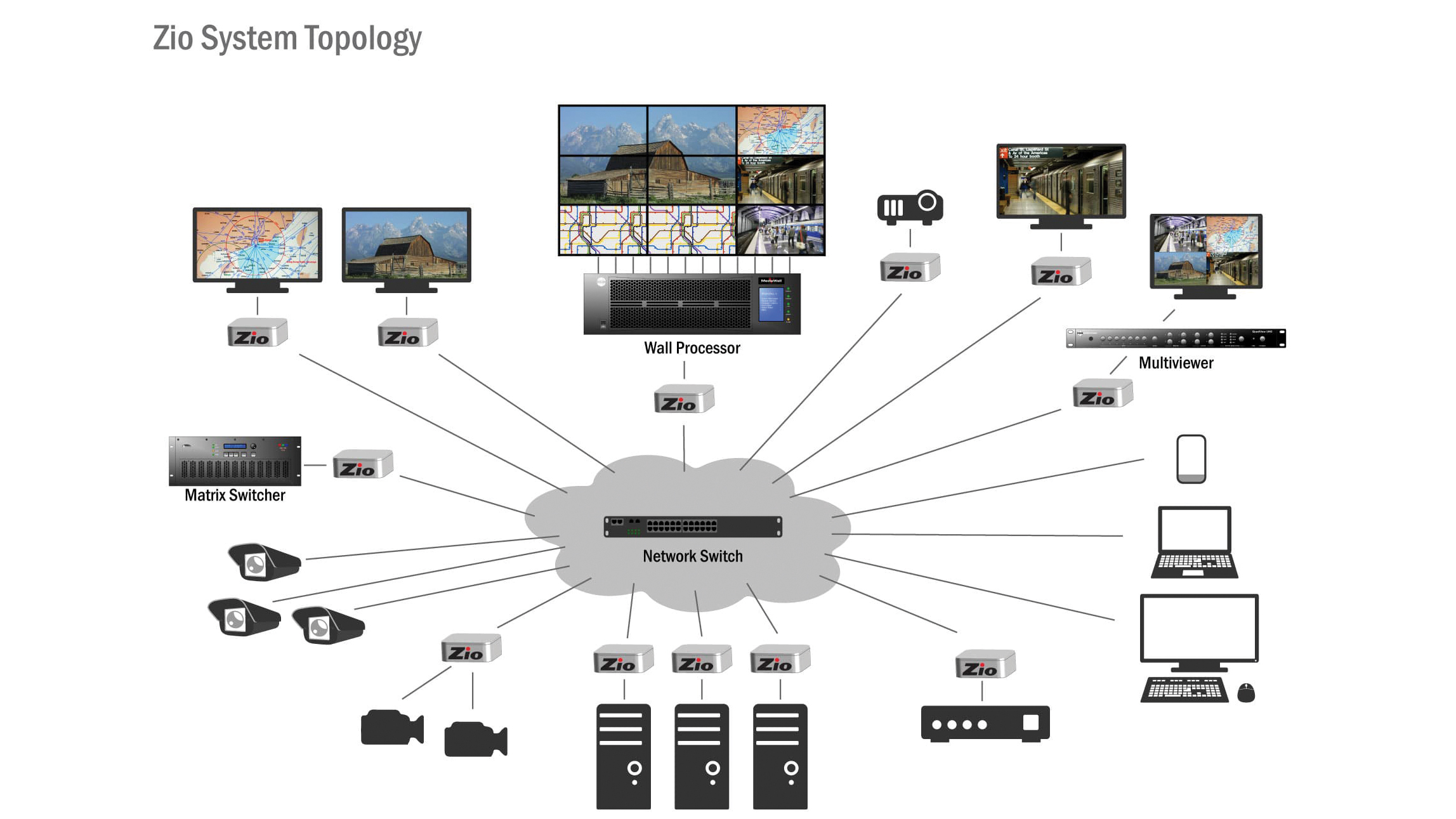
RGB Spectrum Zio
RGB Spectrum’s Zio AV-over-IP solution includes a comprehensive family of encoders, decoders, multiviewers, wall processors, and software for smart displays and mobile devices. It provides an easy-to-use collection of products and solutions for the capture, distribution, and display of video content over IP networks, including not only LANs but WANs and mobile networks. Built specifically for the demands of the enterprise customer, Zio products can adapt to changing requirements for bandwidth, resolution, and latency using industry-standard codecs, enhanced with fully distributed, browser-based control. The inclusion of robust APIs enables third-party integration of control systems, sources, display devices, and other IoT products into the Zio platform.

Silex Insight VIPER
The VIPER HDMI-over-IP platform from Silex Insight is a field-programmable solution based on flexible and powerful FPGA-based micro-electronics. This allows the end user to continuously upgrade this hardware solution as new features and specifications are released by uploading the latest firmware through a web browser. VIPER from Silex Insight allows the customer to keep his systems up to date as the requirements evolve, without replacing any hardware. Continuous developments in video and audio codecs guarantee optimum performance, extending the lifetime of the device threefold.
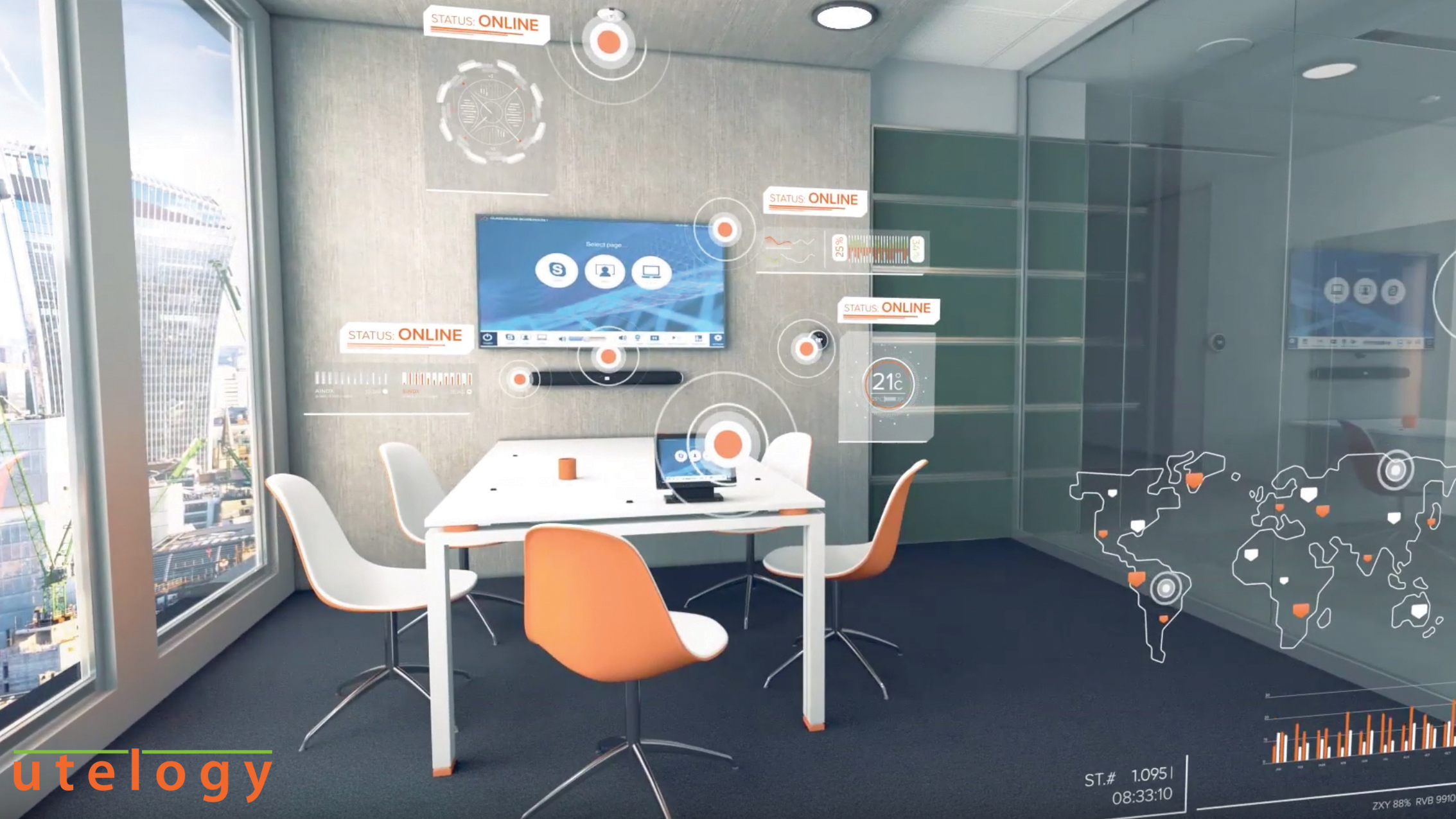
Utelogy U-Manage
As the market seeks efficiency, scale, and value, there is a reduction in the number of proprietary hardware platforms in favor of less expensive, simpler, and more scalable software technologies that sit within the IT world and deliver enterprise-class reliability. We are seeing new vendors that understand scale, value for money, reliability, and the need to deploy globally with a consistent outcome. All of this plays into the hands of IT-type companies and those AV companies that are agile and have built a business around service and support. Utelogy’s U-Manage solution helps both end users and service providers easily transition to this type of service.
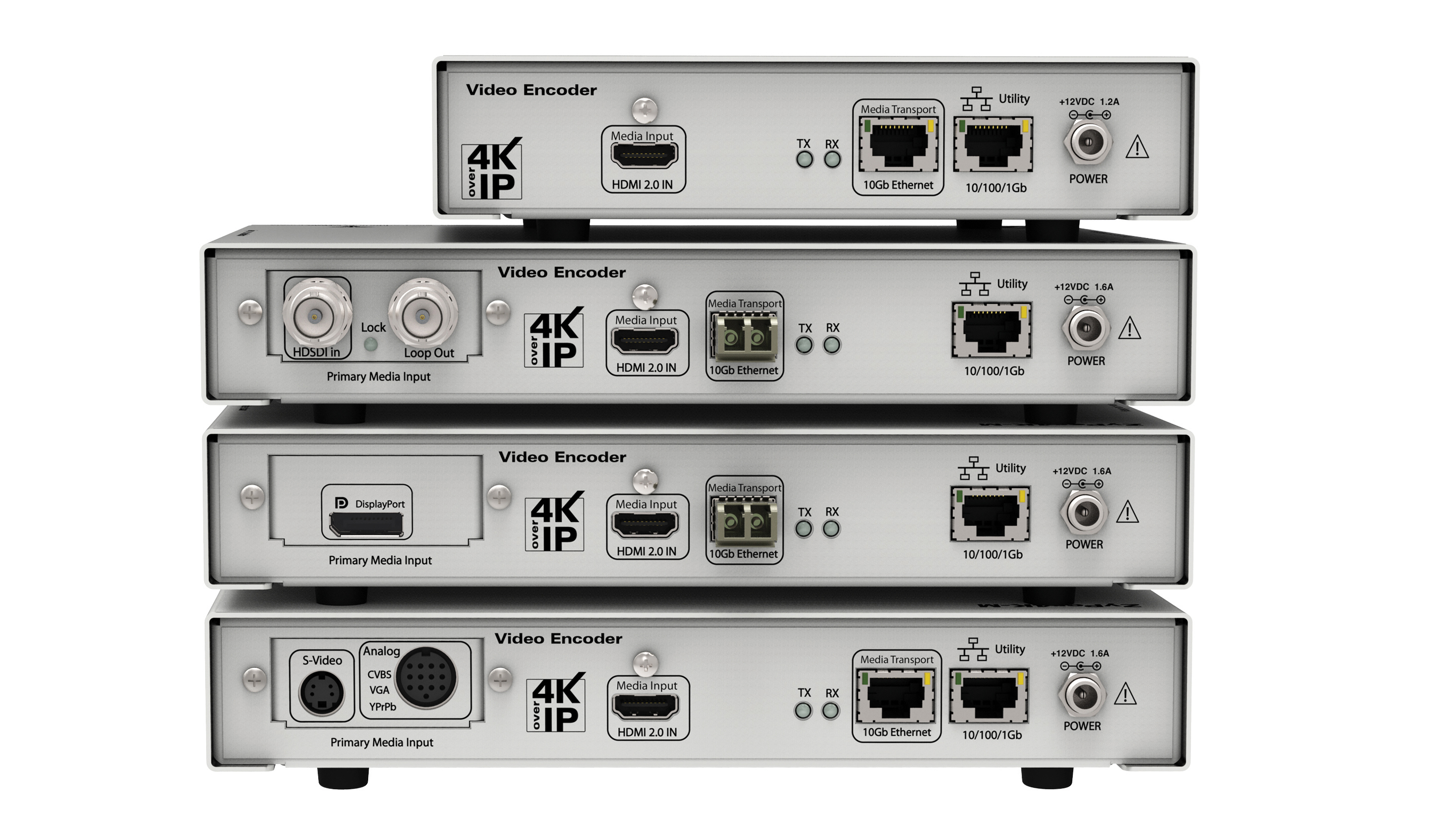
ZeeVee ZyPer
ZeeVee’s ZyPer line is designed from the ground up to make the transition to IP as smooth and easy as possible. ZeeVee’s third-generation AVoIP encoders and decoders represent truly transitional products for those seeking more flexible, scalable, and cost-effective video distribution and streaming solutions. ZeeVee offers an extensive line of mature solutions, from H.264 to uncompressed 4K 60 4:4:4, to address every commercial and professional need. ZeeVee enables flexibility for changing needs by using the same management platform across all of its AVoIP products. The design simplifies setup and day-to-day use and enables the adjustment of configurations, sources, and endpoints.

Cindy Davis is the brand and content director of AV Technology (AVT). She was a critical member of the AVT editorial team when the title won the “Best Media Brand” laurel in the 2018 SIIA Jesse H. Neal Awards. Davis moderates several monthly AV/IT roundtables and enjoys facilitating and engaging in deeper conversations about the complex topics shaping the ever-evolving AV/IT industry. She explores the ethos of collaboration, hybrid workplaces, experiential spaces, and artificial intelligence to share with readers. Previously, she developed the TechDecisions brand of content sites for EH Publishing, named one of the “10 Great Business Media Websites” by B2B Media Business magazine. For more than 25 years, Davis has developed and delivered multiplatform content for AV/IT B2B and consumer electronics B2C publications, associations, and companies. A lifelong New Englander, Davis makes time for coastal hikes with her husband, Gary, and their Vizsla rescue, Dixie, sailing on one of Gloucester’s great schooners and sampling local IPAs. Connect with her on LinkedIn.
